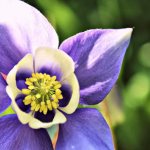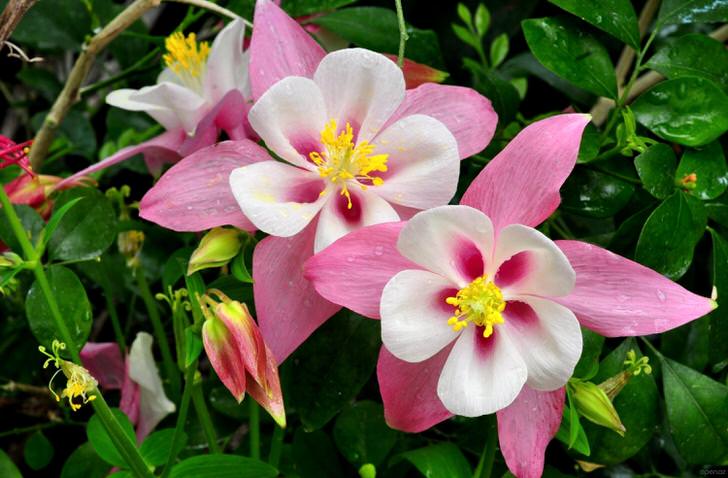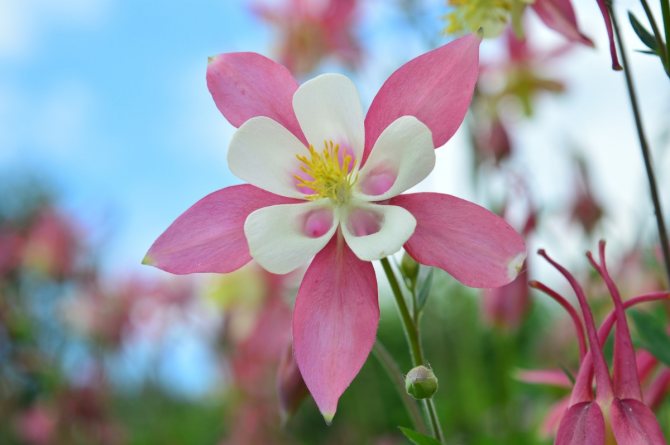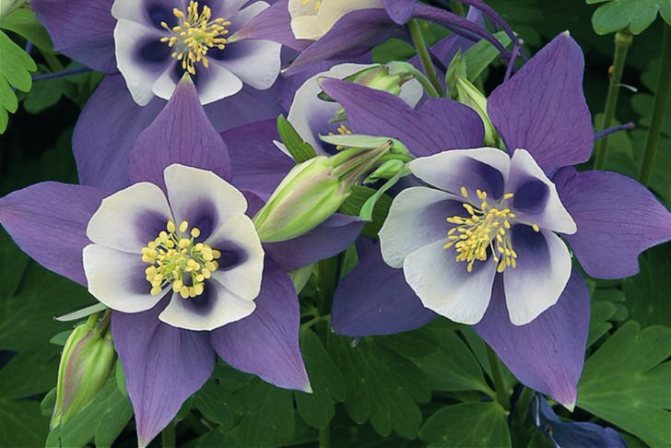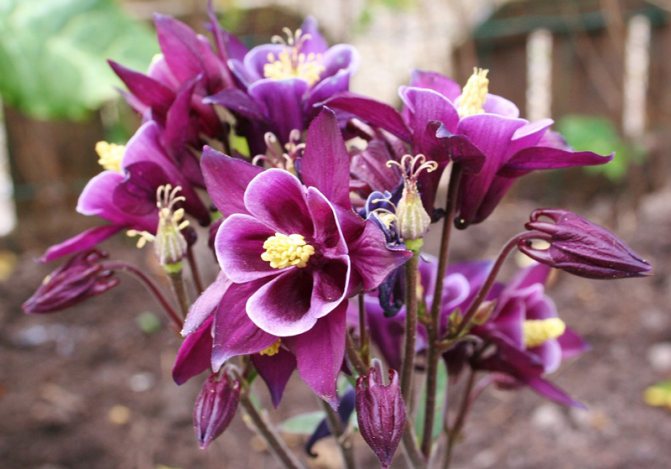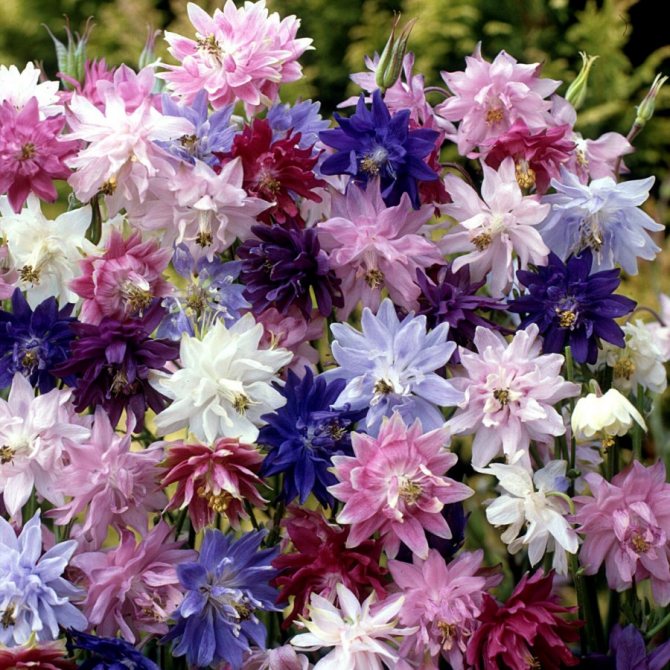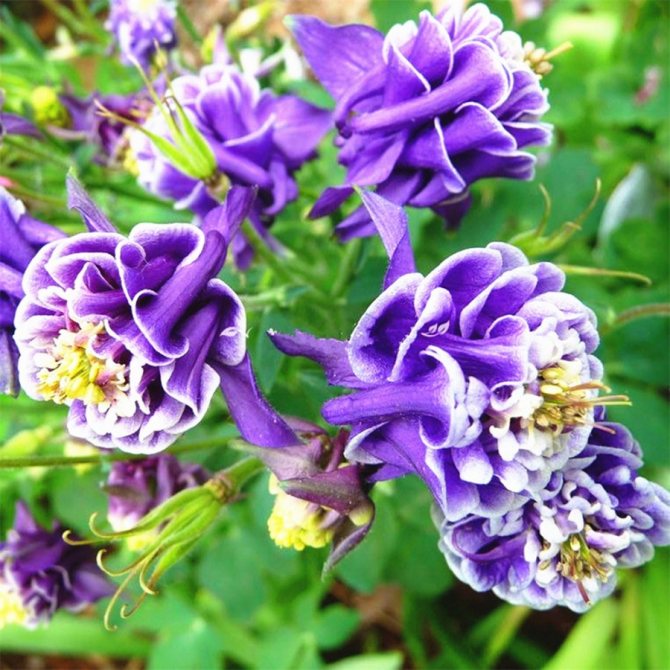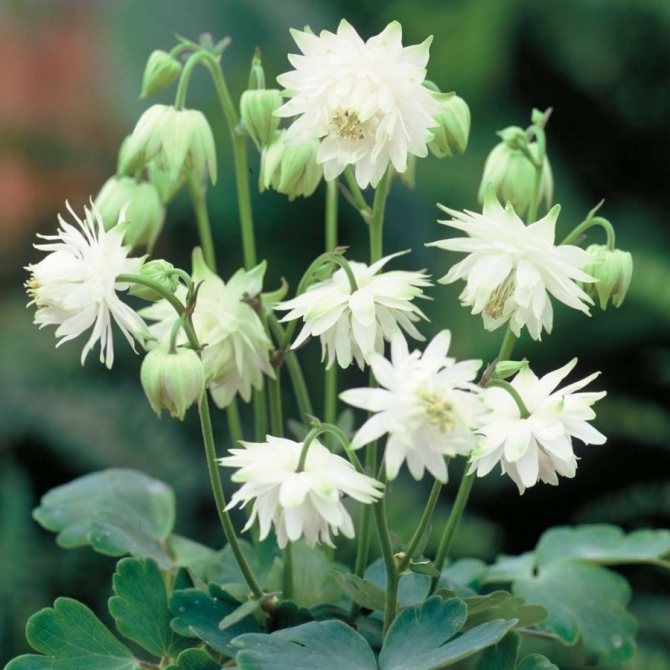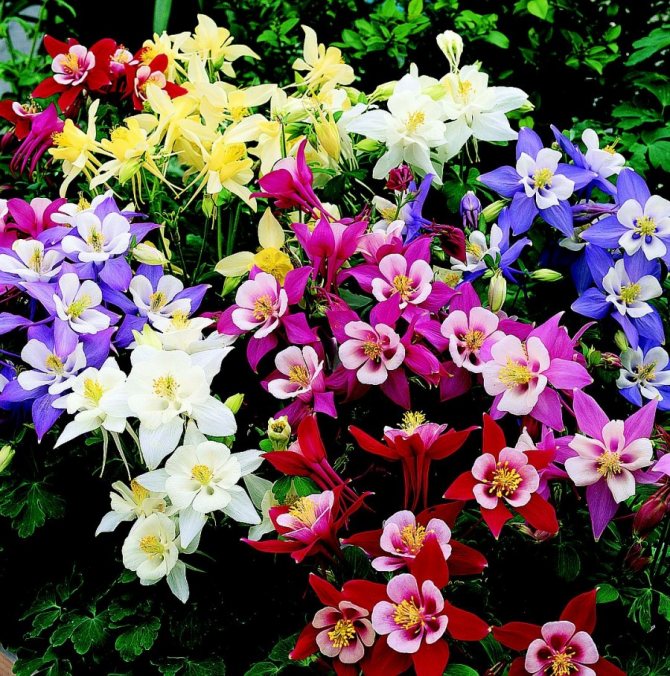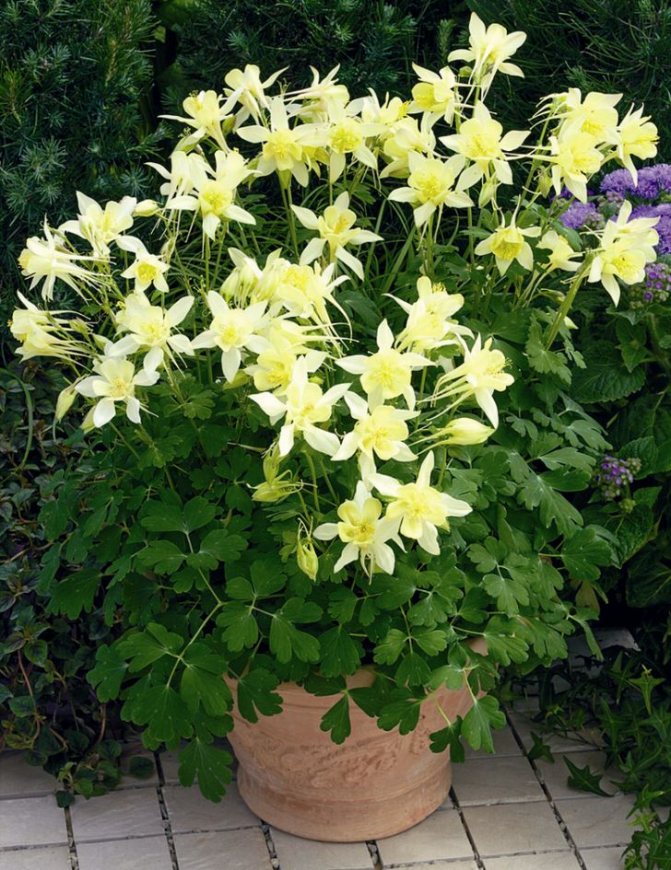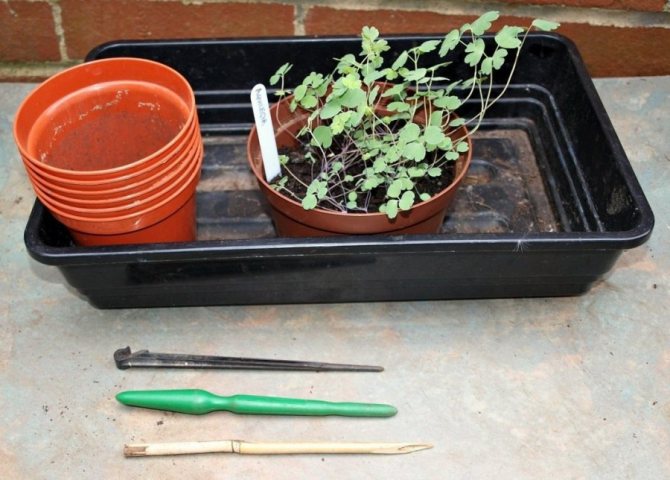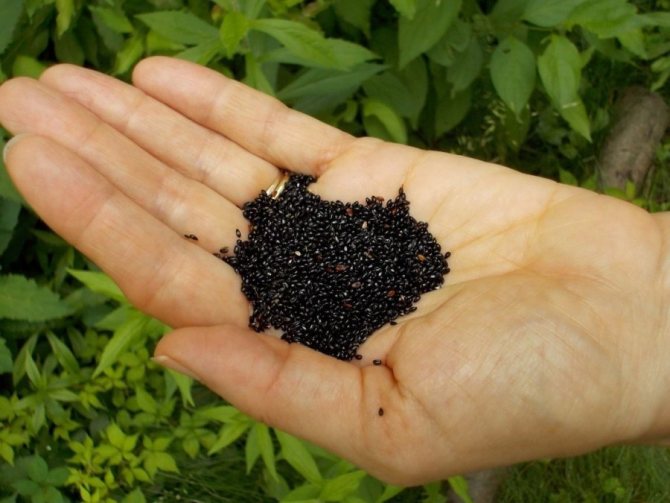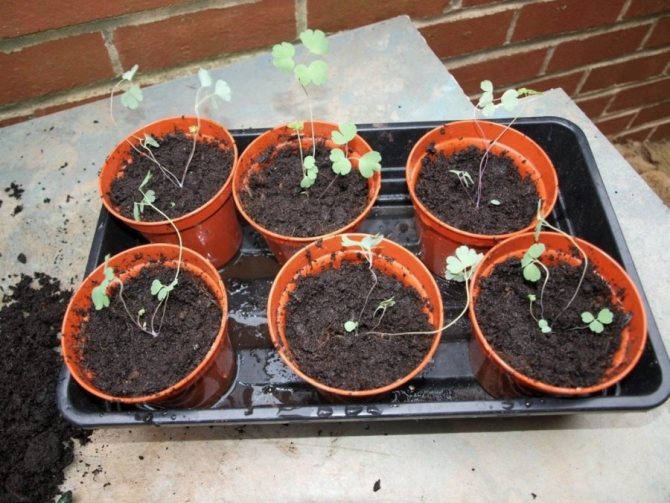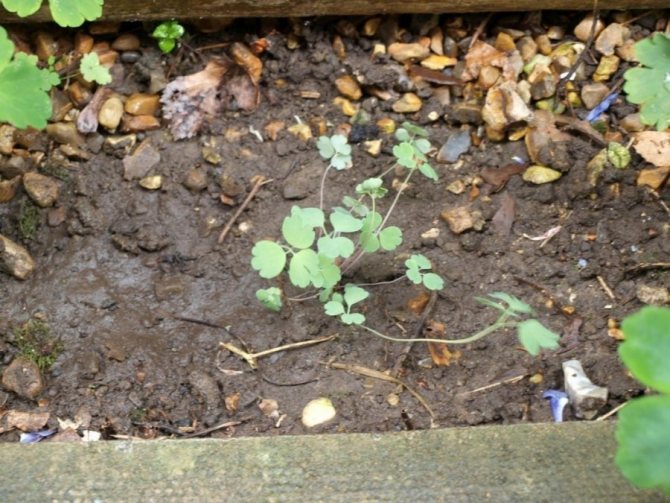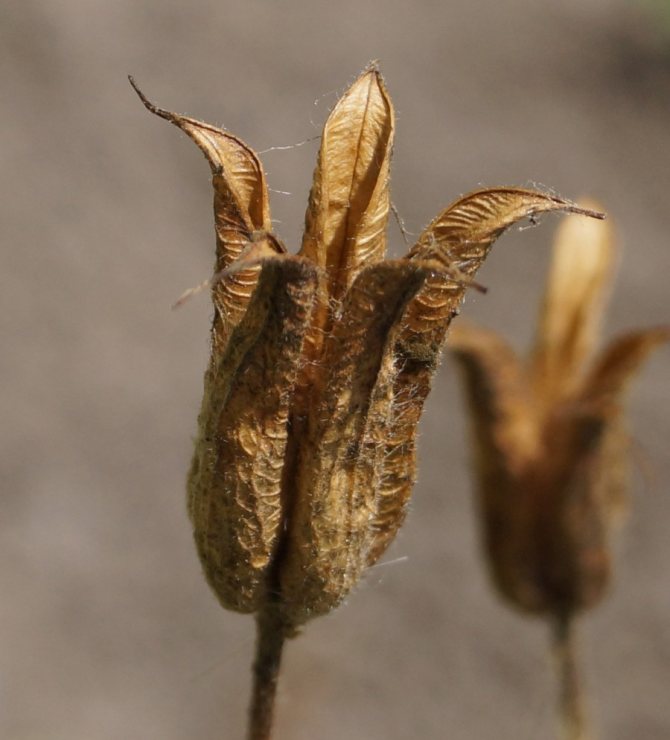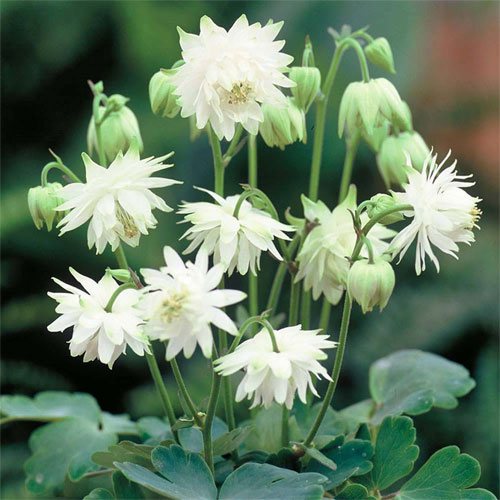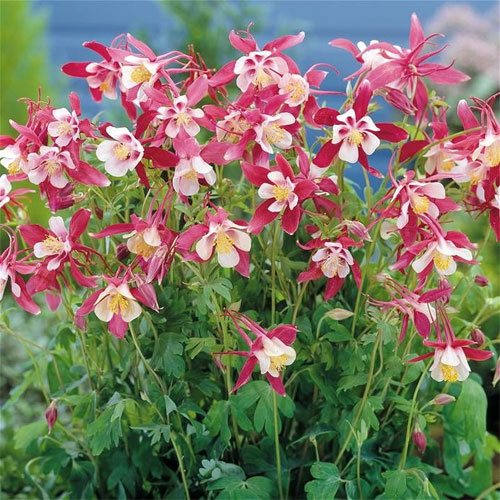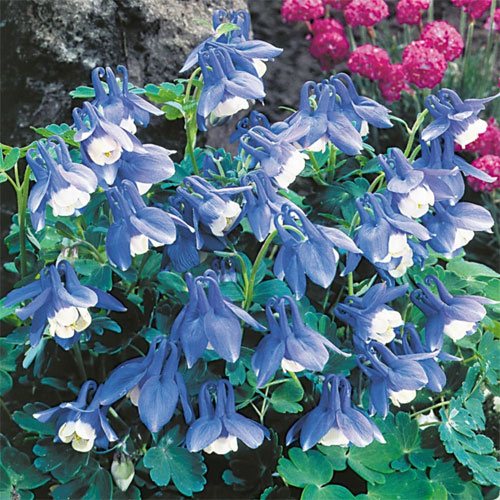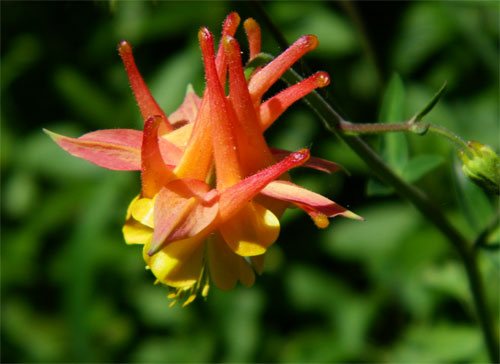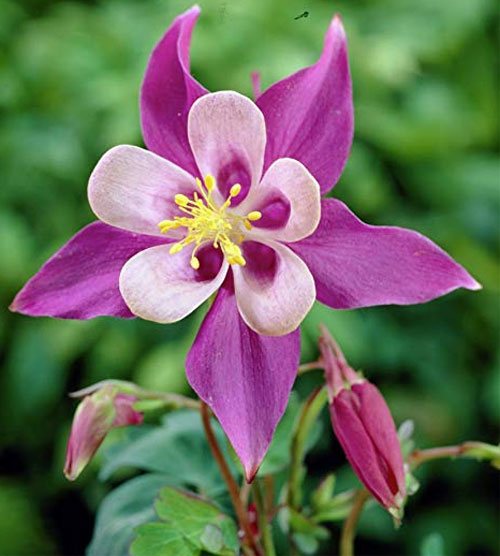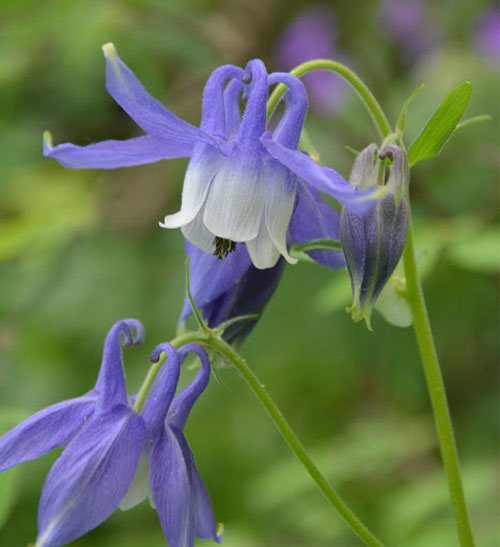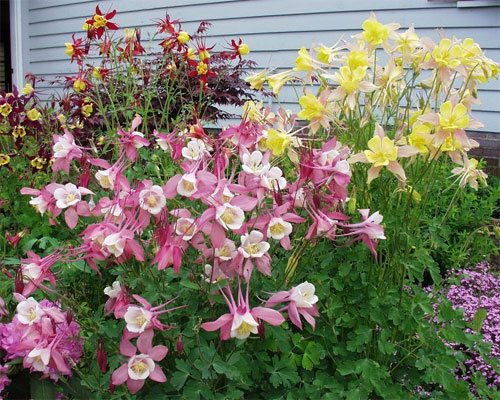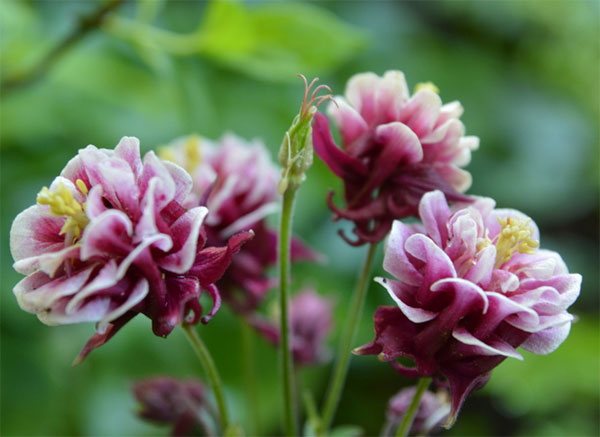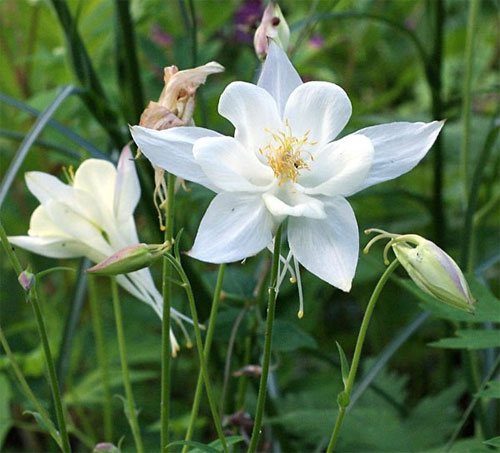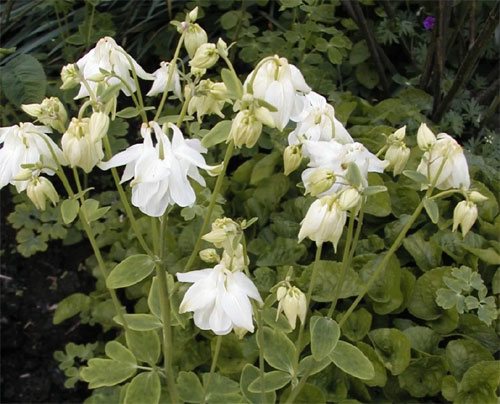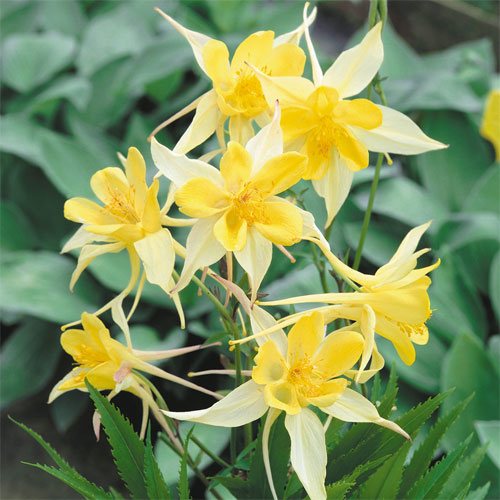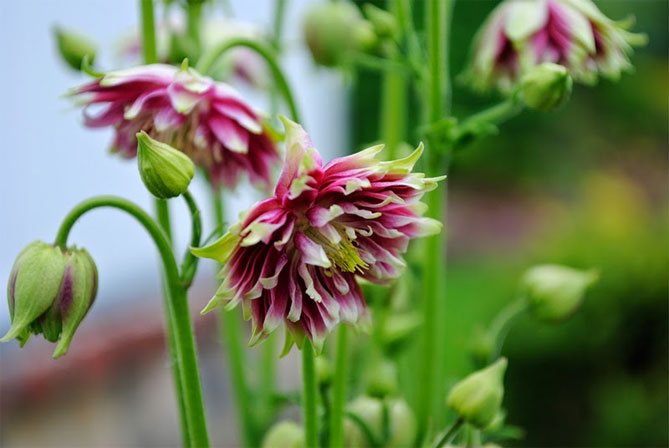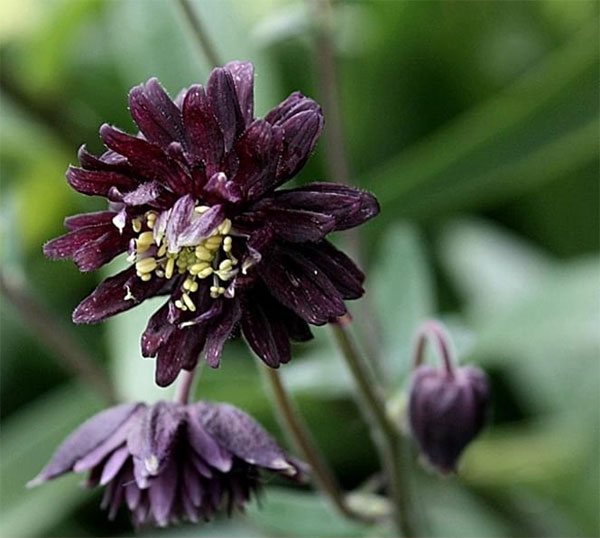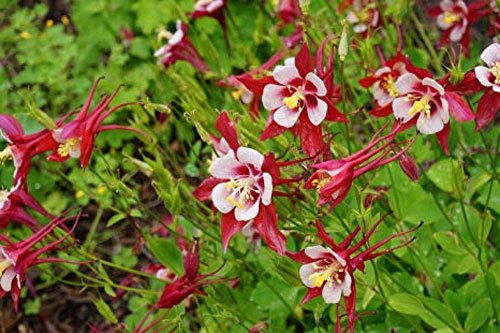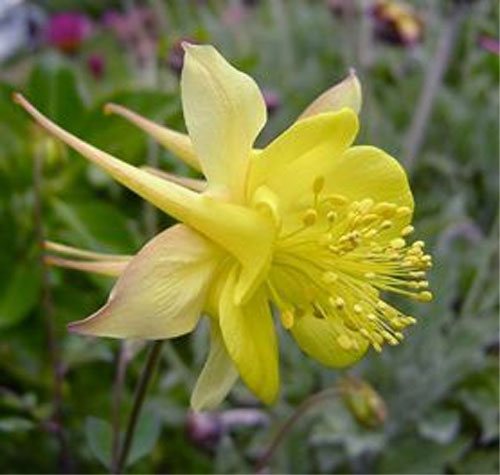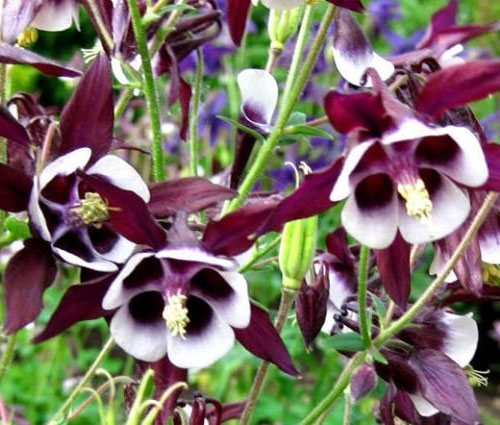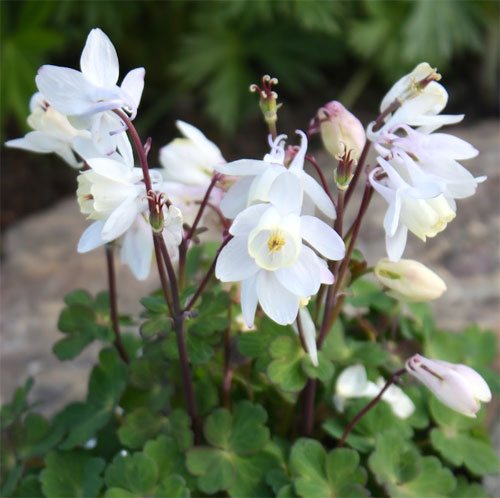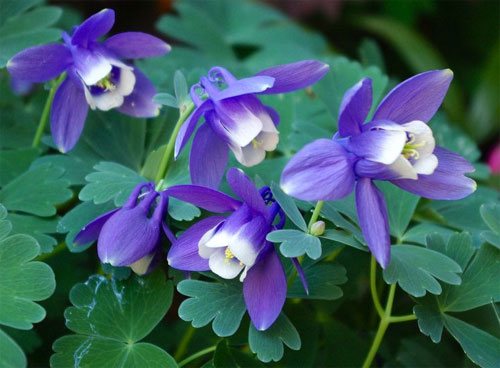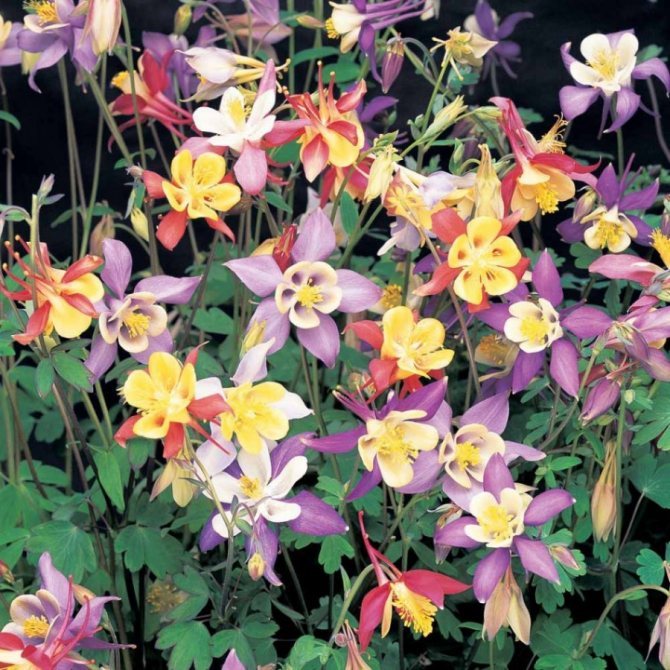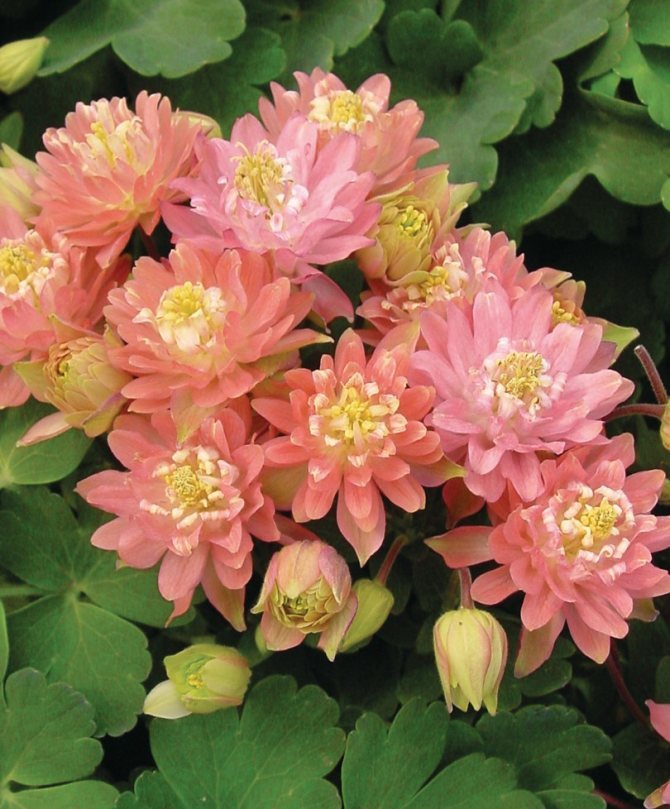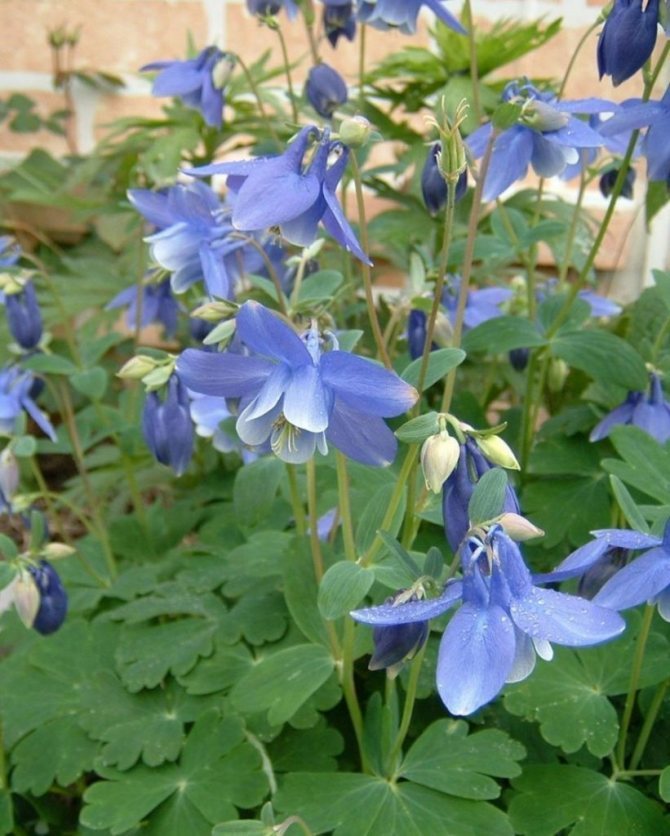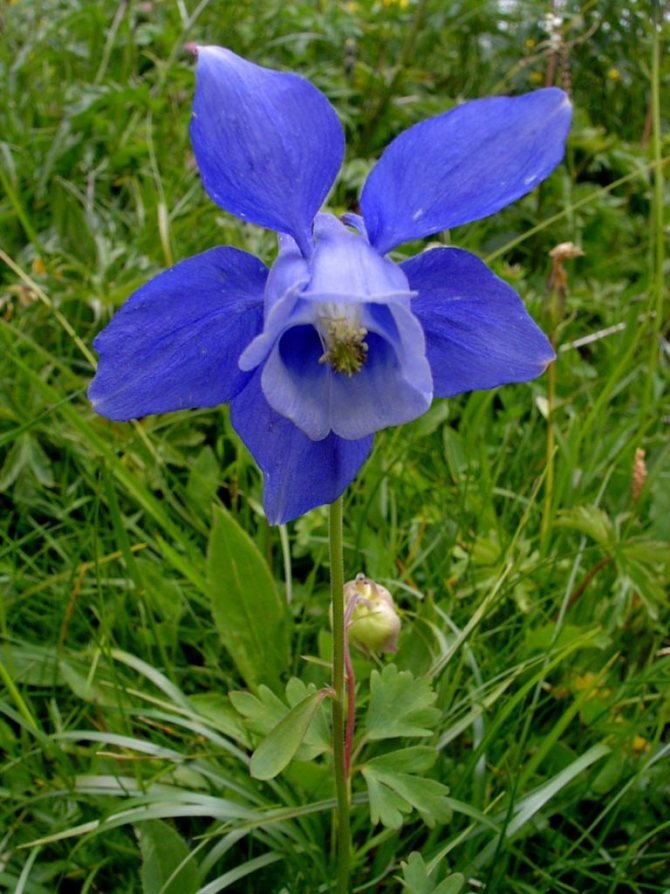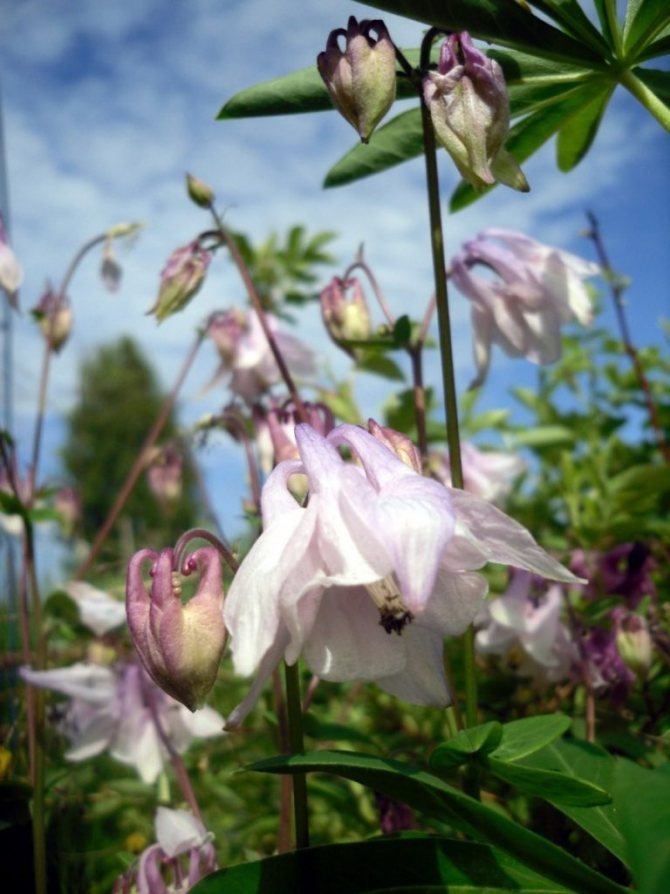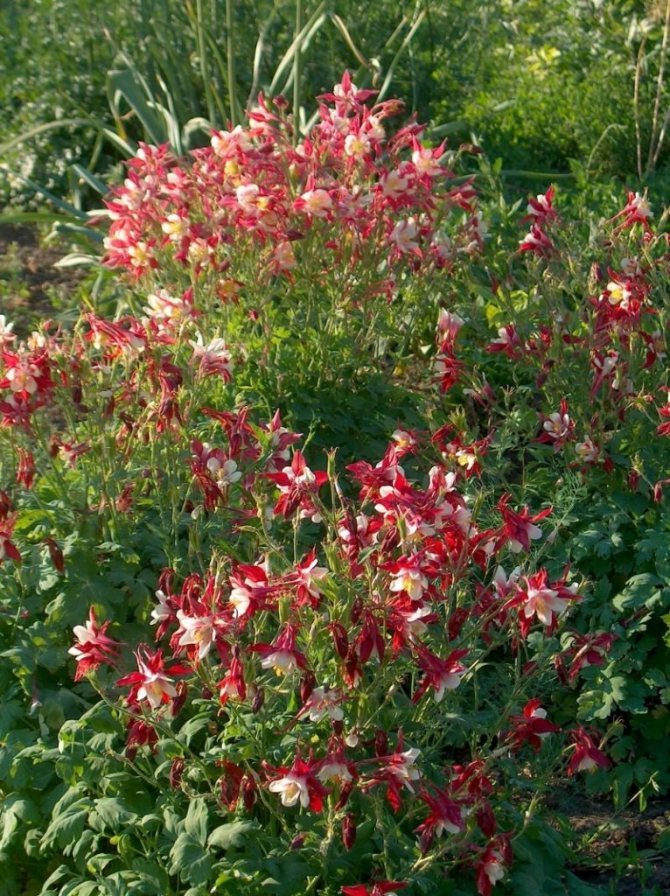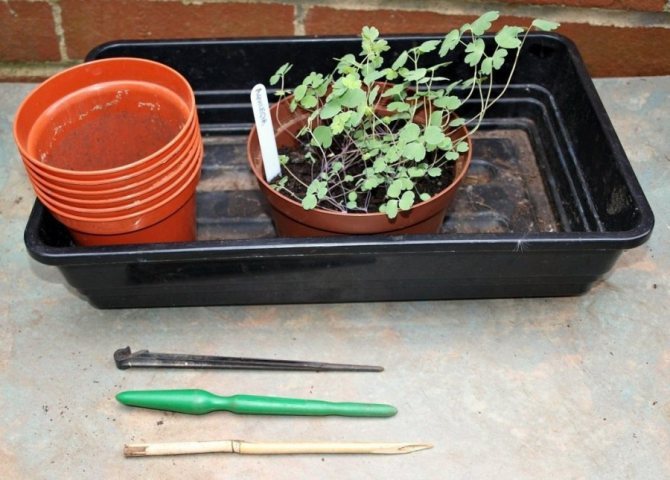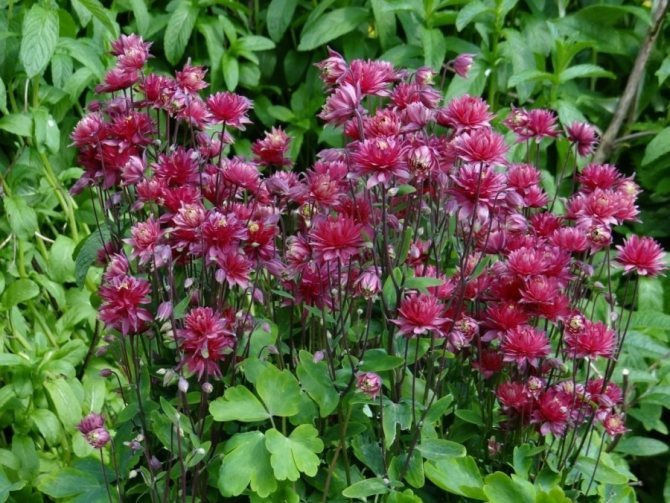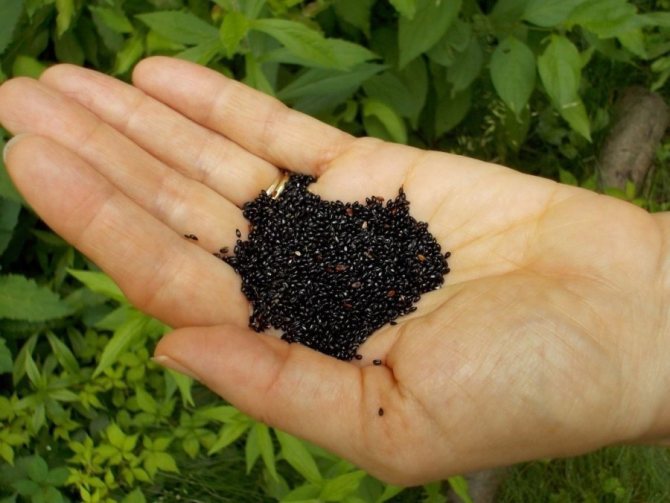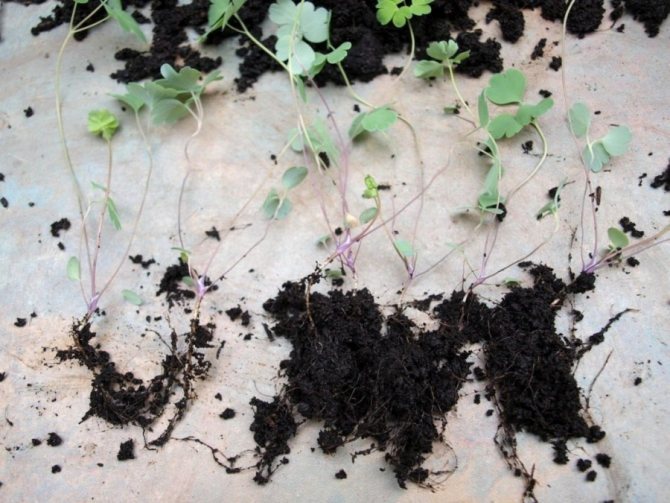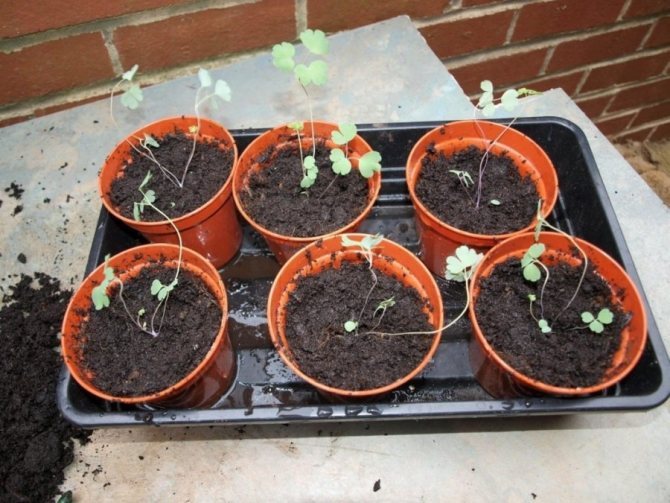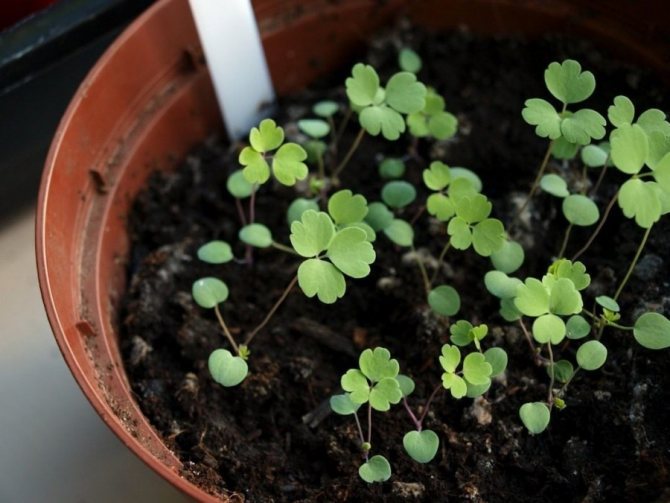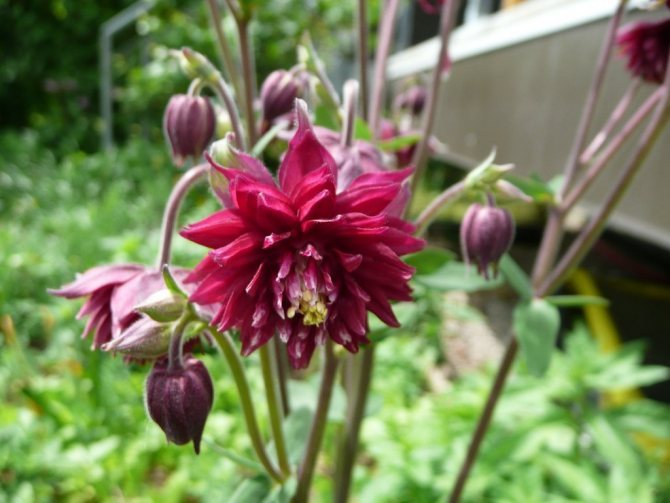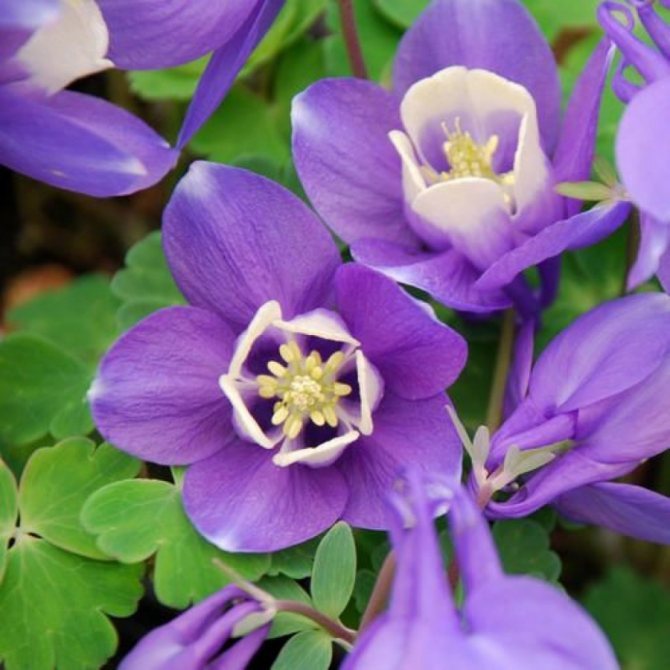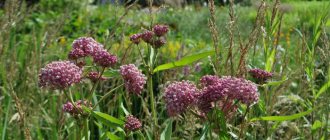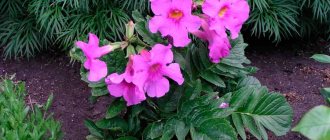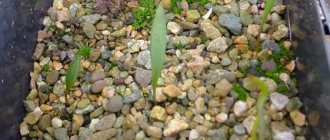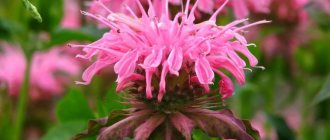Aquilegia has flowers of an unusual shape. They bloom in a lush multi-colored cap over the bush when there is a shortage of other flowering plants in the garden. This herbaceous perennial belongs to the Buttercup family. In its natural environment, it can be found in the temperate and subtropical climate of the Northern Hemisphere. The plant is also popularly known under the names "eagle", "elf's shoes" and "catchment". The plant was so liked by the breeders that they bred many decorative varieties with a wide variety of colors. This allows you to create a truly fabulous flower garden in any garden. Knowing the basic secrets of care, it is not at all difficult to achieve a regular and lush flowering of aquilegia.
Botanical characteristic
Aquilegia or catchment (Aquilegia L.) is a genus of herbaceous plants of the Buttercup family. Other names are also known among the people:
- eagle,
- dove,
- boots,
- bell.
The genus Aquilegia encompasses about 70 species that live in the temperate zone of the northern hemisphere, mainly in mountainous regions. Typical species - Common catchment (Aquilegia vulgaris L.) - a local representative of this species in the European part of Russia, Western Siberia, up to Kamchatka. Many species, hybrids and varieties are grown as garden ornamental plants.
It is interesting! The name Aquilegia comes from the Latin word aquila, which means eagle. This is due to the structure of the flowers, which form a long spur that resembles an eagle's claw.
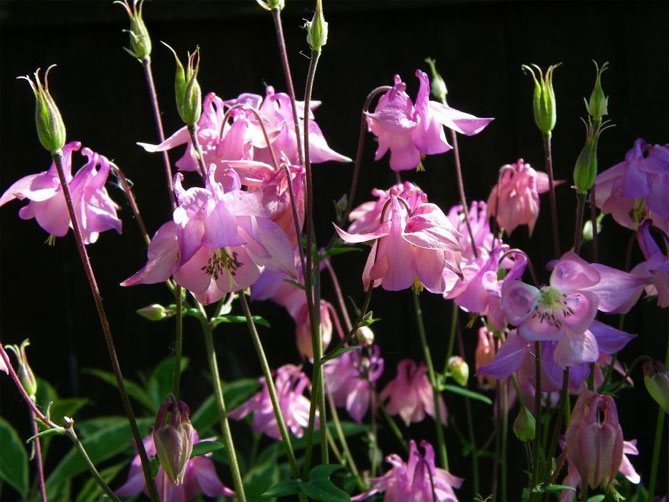
Morphology
- They are perennials with numerous stems growing from a thin, woody rhizome. Above, pubescent with glandular hairs. Shoots have a two-year development cycle.
- Ltruth - located on long petioles, single or trifoliate, separate leaves are dissected.
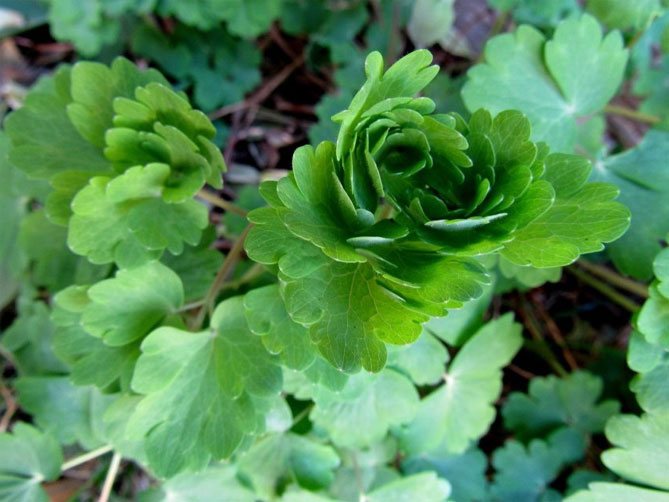

- Cveta - rarely solitary, usually grouped in pairs in the form of an inflorescence. The flowers have an interesting shape and consist of two parts. Outer petals - 5, colors - white, blue-violet, blue, yellow, red. Sometimes both parts of the flower have different colors: white-blue, white-burgundy, pink-purple, yellow-orange. The length of the petals is 7-50 mm. They quickly disappear. There are also 5 inner petals, they are smaller, round, tubular-elongated at the base with slightly curved spurs. The inner part of the flower is filled with long, densely spaced stamens with anthers and several pistils. The flowers are slightly bell-shaped, usually hanging on thin, long peduncles growing from tough, rarely leafy shoot tips.
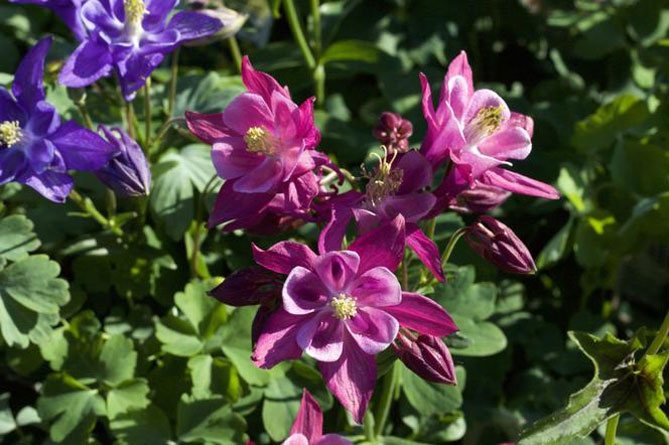

- Fetus - multileaf, numerous seeds, black, narrow-oval, smooth. The seeds of the catchment are poisonous!
Aquilegia blooms from May to July, after flowering, decorative foliage remains in the flower bed. During the flowering period, along with the flower shoot, the plant grows to a height of about 1 m, after flowering only leaves remain. Usually an eagle during this period does not exceed a height of 50-60 cm. There are hybrids characterized by a very small stature that can be successfully used for composition in rock gardens.
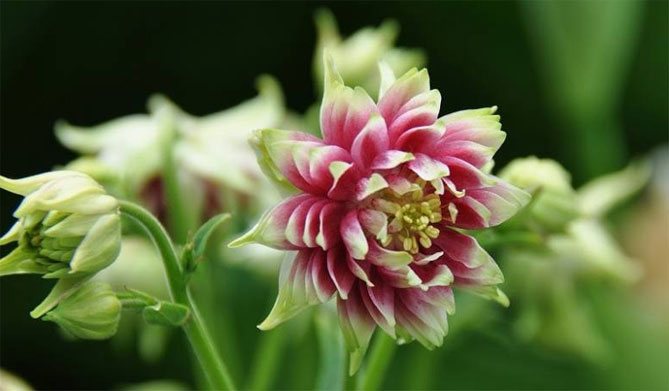

Aquilegia - flower catchment, or perennial catchment
Aquilegia is a compact shrub with shoots, firm and strong peduncles. The bicolor flowers are available in a wide range of colors.Planting and caring for aquilegia in the open field is not difficult for beginners, since the bushes need timely mineral feeding and watering.
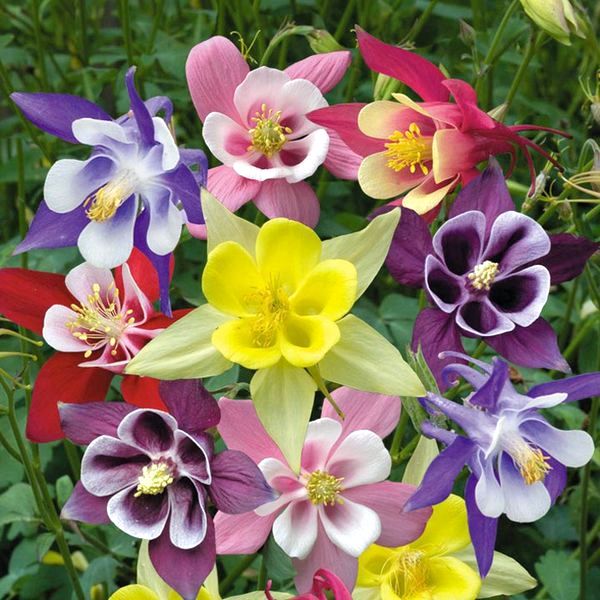

Aquilegia is a compact shrub that blooms spectacularly all summer
The aerial part of the bush can reach 1 m, the roots have a pivotal form and a large number of branches located at a depth of up to 0.5 m. Every year, renewal buds form at the base of the shoots, later they form rosettes from which foliage and flower stalks grow.
Flowering period
An early summer plant is characterized by:
- long peduncles: from 0.6 to 1 m;
- large flowers: from 6 to 10 cm;
- a variety of colors of petals: can be golden, orange, purple, snow-white, bluish, cornflower blue, pinkish;
- corolla with 5 petals, thin spurs: 5 to 7 cm.
For your information! The aquilegia flower collector is a perennial, it blooms at the end of May, from 8 to 12 pieces can be located on each peduncle.
How long does aquilegia bloom
The duration of the retention of the buds depends on the variety. Some varieties adorn plots for one month, in May or June, others - until the first frost. For aquilegia, care after flowering consists in pruning the stems to the root outlet. Then the ripening time of fruits begins - many-leaves, in which small black seeds ripen. Germination is maintained throughout the year, self-seeding is possible.
Important! The catchment fruits are poisonous, accidental consumption can lead to serious poisoning.
Views
The genus Aquilegia includes several dozen species of herbaceous plants that live in the temperate zone of the northern hemisphere.
The most famous species
| Latin name | Russian name of Aquilegia (Vodosbor) |
| Aquilegia vulgaris | Ordinary |
| Aquilegia canadensis | Canadian |
| Aquilegia chrysantha | Golden-flowered |
| Aquilegia Formosa | Lovely |
| Aquilegia x hybrida | Hybrid |
| Aquilegia atrata | Dark |
| Aquilegia alpina | Alpine |
| Aquilegia pyrenaica | Pyrenean |
| Aquilegia discolor | Discolor |
| Aquilegia olympica | Olympic |
| Aquilegia flabellata | Fan-shaped |
| Aquilegia caerule | Blue |
| Aquilegia skinneri | Skinner |
| Aquilegia brevistyla | Brevistila |
| Aquilegia glandulosa | Glandular |


Recommended species for gardening
The following species are grown in the garden:
- Common catchment (Aquilegia vulgaris) - also found in natural landscapes in the wild.
- Fan-shaped aquilegia - from the mountainous corners of Japan. Reaches a lower height, suitable for growing in containers, which makes it possible to revive the design of the balcony, terrace.
- Golden-flowered aquilegia - will decorate a gloomy flower bed with golden color of flowers.
- Alpine - with bluish flowers.
- Canadian - very decorative, yellow-red flowers.
- Glandular - blue-white flowers.


There are a lot of hybrids on sale. It is worth noting that the species cross very easily, so different specimens can be obtained, although they usually will not be as decorative as the original plants.
Table. Height of certain types of aquilegia
| Species name | Height, cm |
| Ordinary | 40-80 |
| Golden-flowered | 80-100 |
| Alpine | 40 |
| Fan-shaped | 50 |
| Glandular | 30 |
| Blue | 80 |
| Canadian | 60 |


Characteristics of individual species
Below is a brief description of the individual catchment types.
Ordinary
An aboriginal species, it is found less and less often. Natural habitats - some areas of Europe, Asia. A relatively tall perennial, the height can reach 100 cm, but more often does not exceed 60 cm. Decorativeness - in leaves, flowers. Leaves are carved, on long stalks, tripartite. Flowers on long petioles with characteristic curved spurs. The color of flowers is very diverse. Blossoms in May; bloom may last until July. In nature, purple flowers are more common.
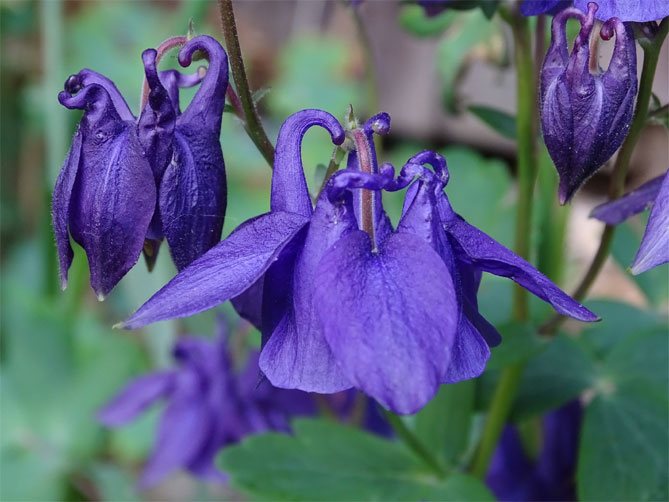

Hardy perennial - relatively undemanding and easy to grow. The plant prefers humus and sandy-humus substrates, moderately moist with medium fertility. Bushes are short-lived, but plants often spontaneously sow.
Grows well in sunny and slightly shady places.
It is interesting! In shady places, ordinary aquilegia blooms better.
The species is used for decorative purposes.The common eagle is usually planted in flower gardens and as a decoration around trees and shrubs. After flowering, it becomes unattractive, so it is better to combine it with other types of perennials. The plant is in harmony with naturalistic and rustic gardens. Also suitable for vases as a cut flower. Planted in the garden next to other plants, it repels snails.
Photo. Aquilegia ordinary
The species is also a medicinal plant used in homeopathy.
Attention! Aquilegia ordinary cannot be used as a home remedy because it is poisonous. Ingestion of the herb can cause toxicity, diarrhea, and breathing problems.
Golden-flowered
The natural habitats of the species are some regions of North America. A tall view, under favorable conditions it can reach a height of 1 meter. It is characterized by triple leaves and very delicate golden yellow flowers. Blooms from May to August.
Photo. Aquilegia golden-flowered
Fan-shaped
Comes from Japan. This is an example of a low species that can be successfully grown in a container, used for flower arrangements on the balcony, terrace. The height of the bush reaches 50 cm, but usually smaller. Carved leaves, blooms in May, characterized by large flowers.
Photos. Aquilegia fan-shaped
Blue
Aquilegia caerulea is found in the wild in North America in the rocky mountains. Reaches a height of 80 cm. In the gardens, colorful hybrids are mainly found, for example "Elena" Helenae with blue-white flowers.
Photos. Aquilegia blue
Hybrid
The Aquilegia x hybrida varieties are formed by crossing different species of the genus. The received samples delight with variability, beauty of shapes and colors. They reach a height of 20-100 cm. Flowers with a diameter of 3-7.5 cm can be monochromatic: white, cream, pink, coral, red, blue or bicolor. Aquilegia hybrids recommended for cut flower production are representatives of the groups:
- Colorado F1,
- Musik F1,
- Olympia F1.
For growing in containers and rock gardens suitable variety "Mini-Star" and hybrids of the Cameo group. The hybrids of Little Beauty, Spring Magic, Songbird F1 and Winky are valuable in terms of average vigor. An example of a hybrid with large flowers and variable shades is Spring Magic.
Interesting hybrids of aquilegia with double flowers - representatives of the groups:
- Barlow,
- Clementine.
Learning to grow with seeds
It is recommended to immediately plant the seeds in the ground after collecting the seeds - seedlings should be expected in the spring, after which they can be transplanted to their permanent habitat.
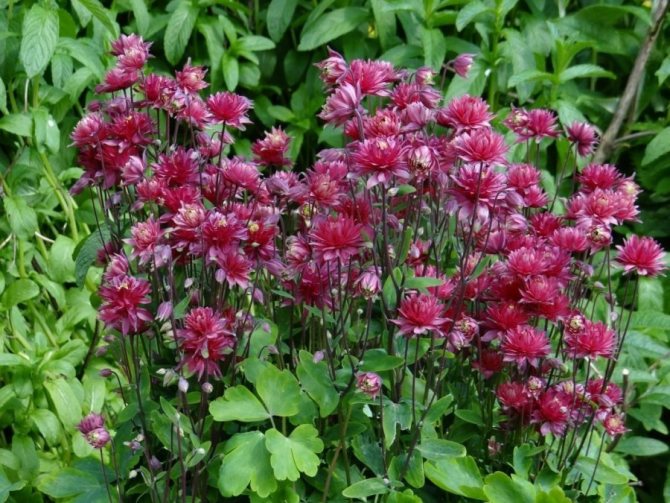

But sometimes it makes sense to postpone the sowing process until spring time. In this case, the seeds need to be stored on a low temperature basis. To preserve their germination, they are contained in the potting mix in the refrigerator.
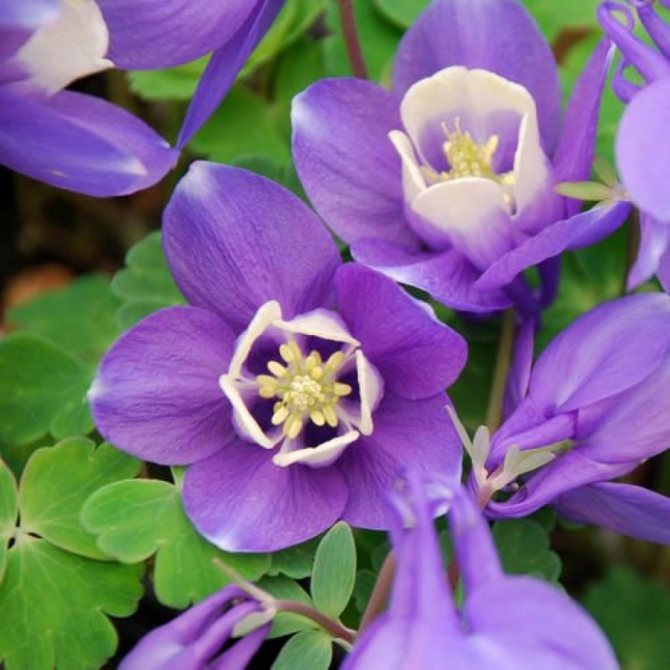

In March they can be used for this it is necessary:
- Rinse the seeds to get rid of the presence of earth;
- Sowing takes place on the basis of a box with sufficiently compacted soil without voids. It is watered with a light version of the substrate, consisting of sand, humus, leafy earth, on the basis of identical proportions;
- The seeds are laid out on the soil and then watered with a soil layer using a sieve until a crust of 3 mm is formed. The box must be covered with burlap or regular newspaper;
- The sowing container is located in the shaded area of the housing based on a temperature of 16 - 18 degrees Celsius;
- The top layer must be moistened after noticeable drying - a spray bottle is used.
The first shoots can be expected a few weeks after the sowing date. After the appearance of the first pairs of full-fledged leaves, you can proceed to the next stage of cultivation - the shoots must be transferred to a loamy soil. This usually happens in the last days of April or the first days of May.
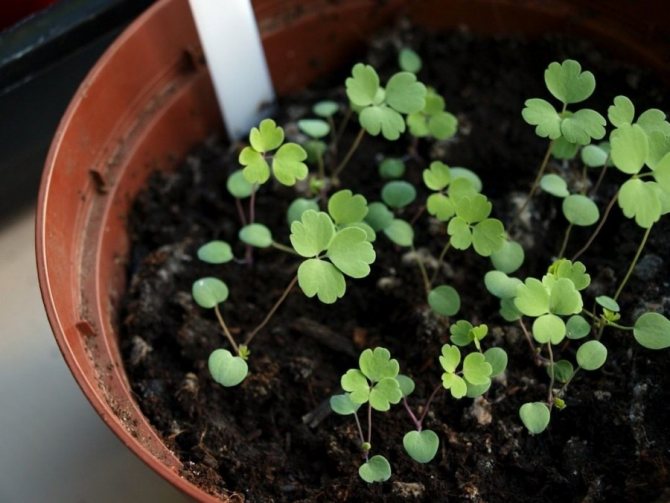

Interesting varieties
| Variety name, short description | Photo |
| Green Apples - a variety with very interesting, greenish flowers |
|
| Crimson Star - a cultivar with white and red flowers |
|
| Ministar - low-grade with white and blue flowers |
|
| Flore Pleno - golden-flowered terry aquilegia |
|
| Pink Bonnets is a very interesting variety with delicate pink flowers |
|
| Helenae - blue-white hybrid |
|
| Mc Kana Hybrids - hybrids of various colors with large flowers |
|
| Winky Double Red White - low varieties with double flowers |
|
| Silver Queen - golden-flowered eagle with white flowers |
|
| Nivea is a variety of the common catchment area with white flowers |
|
| Maxi - variety with yellow flowers |
|
| "Nora Barlow" Nora Barlow - a variety of the common eagle with pink flowers with a white edge |
|
| Black Barlow - a cultivar with purple flowers |
|
| Red Star - a cultivar with red and white flowers |
|
| Yellow Star - yellow flowers |
|
| William Guinness - a cultivar with purple-white flowers |
|
| Cameo White - a variety of fan-shaped catchment with white flowers |
|
| Blue Angel is a fan-shaped catchment variety with blue flowers with a white center |
|
How to integrate aquilegia into the design of the site?
When developing the design of a garden plot, it should be borne in mind that aquilegia can be planted singly, in a group, as well as in close proximity to other plants. An eagle with lupins and foxgloves will have a successful neighborhood. The catchment leaves look good paired with carved astilbe bushes. You can consider them in partnership with gravilat and bells.
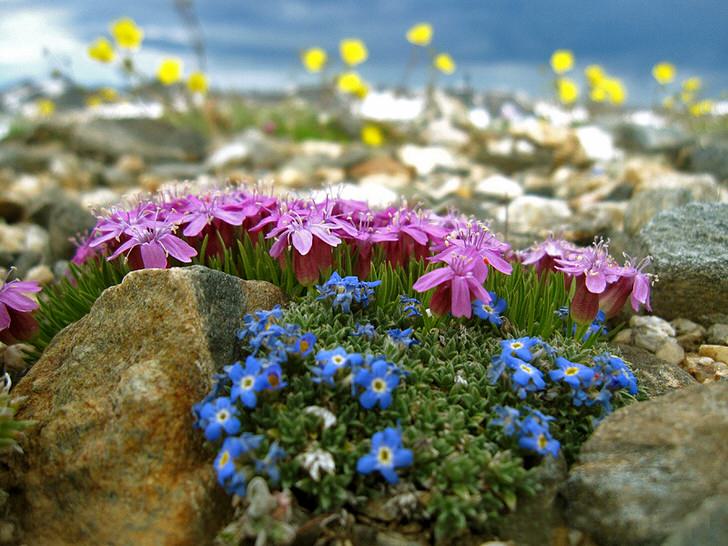

Aquilegia fits perfectly into any version of the alpine slides.
Aquilegia is a seasonal plant that looks great in a bouquet. When choosing a suitable site for a plant, you need to know that this flower is weakly poisonous. It may not come to death, but it is better to play it safe and keep the catchment away from children.
Elven shoes keep the foliage fresh until late autumn, so they will successfully support the design of the flower garden during its withering period.
Growing conditions
The best position to grow aquilegia is in a warm, sunny or semi-shaded area. Eagles are short-lived perennials that prefer partial shade to sunny positions. In too shady corners of the garden, they bloom less, in full sun they are more abundant, but the flowering period is shorter. The common catchment species blooms better in partial shade.
Optimum soil characteristics for aquilegia:
- fertile, humus;
- wet;
- reaction - from neutral to alkaline.
Attention! Dry soil significantly shortens the flowering period of the aquilegia.
There is no need to worry about wintering aquilegia, the plant is resistant to our climatic conditions and low winter temperatures.
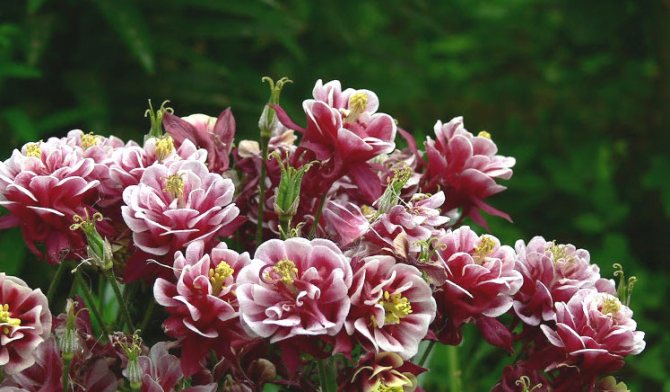

When can I transplant into the ground?
In this issue, too, not everything is simple, since for a start, planting is carried out into the ground for the growing process. When the aquilegia planting is carried out, it is necessary to protect the young plant from the merciless effects of the sun's rays.
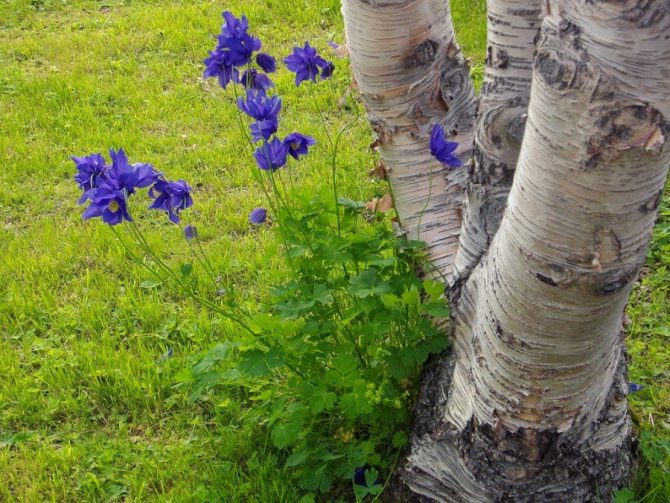

Transfer to a permanent place of life for the successful development of aquilegia for several years occurs in August or with the first days of spring next year. Here aquilegia may develop on the basis of partial shade or the scorching rays of the sun.
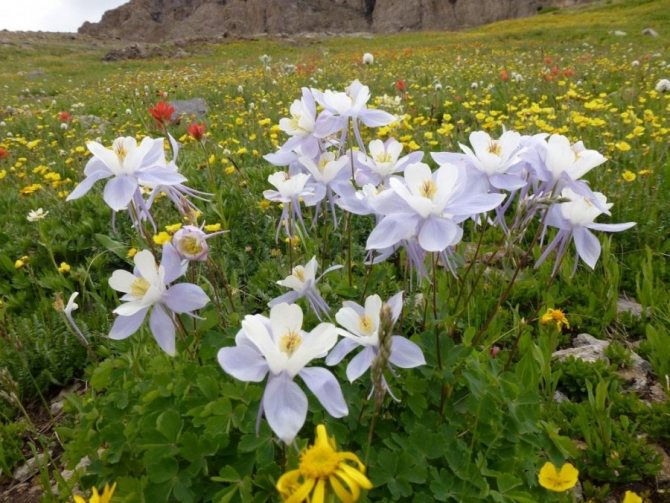

Important: Too much lighting will shorten the flowering period, and the flower shape will be smaller and more fragile than that of plants grown in partial shade.
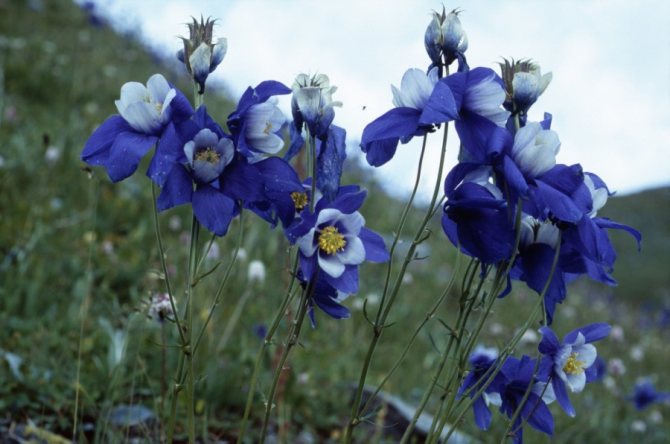

Aquilegia grown with seeds gives the first flowering from the second year of life. Full maturation is achieved in the third year of their development.
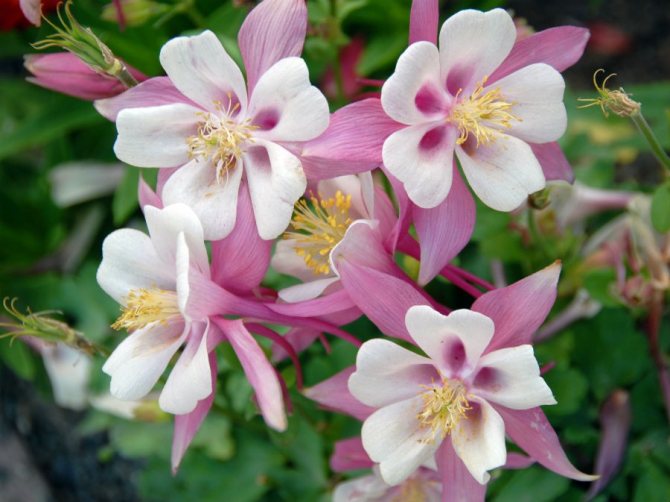

Landing
You can grow aquilegia seedlings from seed or purchase from a nursery. The offer is great and you can also buy less common types and varieties.
Before planting aquilegia, you need to prepare the soil:
- remove weeds;
- if necessary, enrich the soil with well-rotted compost - it will supplement the soil with humus, which will make it more absorbent. Moisture and nutrients are better retained in this environment.
When planting, remember that the height of individual species and varieties varies. The distance between seedlings should be up to 50 cm for the tallest varieties.
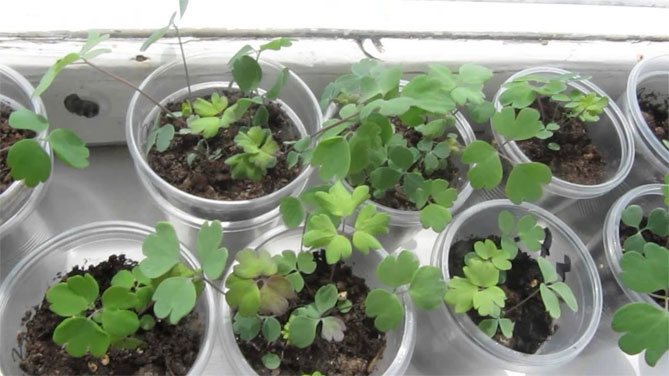

Seedling aquilegia
Choosing a site for planting and preparing the soil
In the natural environment, the catchment prefers places where it is humid enough, and the shade of trees and rocks protects from the bright sun. Wooded areas, the banks of reservoirs, mountain slopes - this is where you can find this plant. Aquilegia will be grateful if you settle it on a plot in partial shade with moist and fertile soil. It can grow both in open sunny areas and in shady corners. But when the sun is bright, the catchment often stretches out and needs more watering, and in the deep shade it often gets sick.
When placed in the garden, the size of the plant is taken into account. Compact varieties suitable for alpine slides, container growing. Tall and medium-sized look in mixborders, flower beds, near ponds. In group plantings, it is better to place the catchment from the edge; in the middle of the composition, its beauty is lost.
The land for planting is carefully and deeply dug up, since the long and developed taproot of the aquilegia must receive enough oxygen and moisture. The plant is undemanding to the composition of the soil, but for better growth and flowering, compost and mineral fertilizers are added to the ground.
Growing and care
Aquilegia flowers seem to be very delicate, but in fact they are very strong and resistant. Eagles thrive in a semi-shaded position, which is why they are one of the main perennials used to revitalize the shady corners of the garden. Thanks to them, flower arrangements are expressed and admired with variety and sophistication.
Most often cultivated aquilegia species are not difficult to grow, their cultivation can be recommended even to inexperienced amateur gardeners. Species that naturally spawn in vastly different environments, such as mountain eagles, can be problematic.
Aquilegia bloom from May to August. After flowering, it is best to prune them so that the plant mobilizes forces to produce new leaves. The procedure is desirable due to the aesthetic appearance of the catchment area after flowering - the leaves can become victims of fungal diseases.
If the moisture content of the substrate is too low, it is worth replenishing the lack of water. To reduce evaporation, plants can be mulched, which will also reduce the spread of weeds. When the aquilegia begins to grow, it is worth freeing up, weeding the space around the bushes.
Aquilegia care
Aquilegia is unpretentious in planting, growing and care. Watering, weeding, loosening the soil, feeding it is necessary in a regular mode, without any particular difficulties.
Equally well tolerates moderate drought and frosts, which are common for the climatic zone.
This is facilitated by a well-developed and deeply penetrating root system of the catchment.
Fertilizing aquilegia
Aquilegia is fed twice a season. At the same time, she needs mineral fertilizers: superphosphate, saltpeter, potassium salt (50, 25, 15 g) and watering with a weak infusion of mullein or bird droppings.
Aquilegia after flowering
After flowering, aquilegia loses its decorative value. To conserve vitality for a new cycle, the ground parts are cut off. If seeds are needed, the stalks with the set multileaf fruits are left to ripen.
It is important to cut off the fruit-bearing plants before the pods open and spontaneously spill their contents onto the ground.
Wintering
The plant is frost-hardy and winters well even in northern taiga conditions. No special shelter is required for the winter. The exception applies to old bushes at the age of 4-5 years.
They are either removed and replaced with young ones, or, if for some reason the specimen needs to be preserved, it is covered with a layer of humus, which will help keep the roots from frost.
The catchment area is suitable for forcing. It will bloom at home in the month of April, if rhizomes are dug up in the fall, planted in large tall flower pots and put for the winter in a cold unheated room until the end of January.
For example, in a basement, garage, closet or veranda. Then take it out and place it in a well-lit place at a temperature of + 12 ... + 16 ° C. A window sill is ideal for these purposes.


Growing in pots
Soil for growing aquilegia in pots, containers should contain about 15% clay and composted bark. You can add slow-acting fertilizers containing additional iron and trace elements, the pH of the medium should be 5.5-6.5.
Temperature for growing in pots:
- at the beginning of the cultivation period, the temperature should be maintained at 14-16 ° C;
- after rooting of plants - the temperature should be lowered by 2-4 ° С.
In the initial period of growth, it is recommended to give plants complex fertilizers of the same composition once a week. By the time of flowering, the aquilegia should have 10-15 true leaves.
To cause the aquilegia to bloom in the autumn months (from October), artificial lighting must be added (the length of the day should be 14 hours).
As a rule, aquilegia are frost-resistant. They grow well in a sunny or partial shade position, lack of light weakens flowering and makes flowers paler. With excessive moisture, the roots quickly turn brown and die off.
The chemical composition of aquilegia
Botanists and pharmacologists have yet to identify the chemical composition of aquilegia. It is poorly studied due to the fact that the plant has not yet found application in official medicine. It is only known that the leaf of the plant contains:
- 0.05% aquileginine alkaloid;
- cyanogenic glycosides;
- fixed oils;
- vitamin C.
All parts of the plant are poisonous enough - cows, horses, other farm animals on free grazing bypass it.
Reproduction
Aquilegia can be propagated in 2 ways:
- vegetative (division),
- generative (seeds).
Sowing seeds, growing seedlings
Plants are pollinated by insects and multiply easily from seeds, which they set in large numbers. In gardens, different types of aquilegia easily overlap, so if you want to plant a certain variety, you need to purchase seeds. Depending on the variety, 1.5-5 g of seeds are required to produce 1000 plants. Seeds harvested from the plant often do not replicate the characteristics of the parent plant.
If the seeds are sown in the spring, the plants will usually only bloom the next year. Seeds can be sown immediately after harvest (June-July), remembering that many forms are self-seeding.
Table. Dependence of the planned flowering period on the sowing date
| Sowing time | Flowering period |
| February-May | July-November |
| Mid July - end of August | Mid March - mid May |
| Mid-May to late June | From february |
Growing seedlings from aquilegia seeds:
- The temperature during seed germination should be maintained at 21-24 ° C. Seedlings will appear in about 10-14 days. Seeds are best sown in multi-cell trays and, although they germinate when exposed to light, it is preferable to cover them with vermiculite.


- When the cotyledons appear, the temperature should be reduced to 18-20 ° C.
- After 5-6 weeks, the seedlings should be dived into trays with larger cells. In the photo, the plant is one month after sowing.
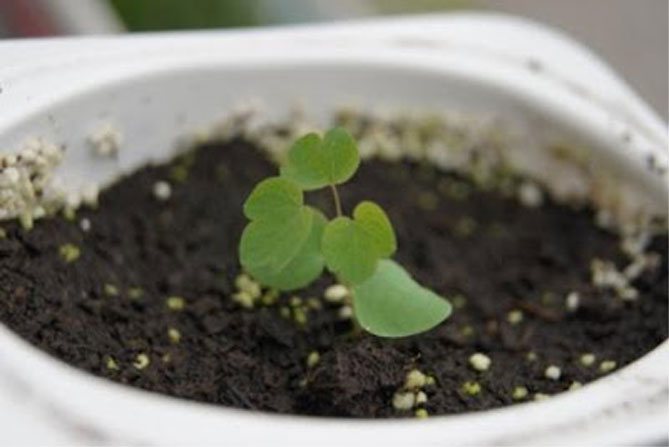

- Seedlings are planted in pots after another 4-6 weeks, depending on the variety.
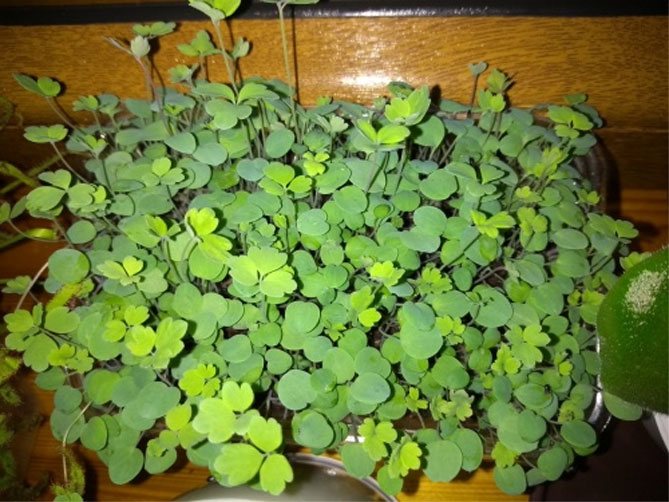

Planting scheme in pots:
- 1 plant is planted in pots with a diameter of 11-12 cm,
- 2-3 plants - into larger ones (13-15 cm).
Reproduction by division
If you want to preserve the characteristics of the original mother plant, it is better to get young seedlings by dividing an adult plant that forms underground rhizomes, because aquilegia very easily pollinate each other. The division of the bush should be planned after flowering plants - in August. Careless division of the bush can lead to the death of plants due to trauma to the root system, it is important to carry out the event with the least amount of damage.
You can allow the plant to scatter the seeds, and in the spring, transplant the resulting seedlings to the desired location. The flowering of plants can be a pleasant surprise, because new specimens created from crossing can have unusual, amazing flower colors.
Use in the garden
In landscape design, aquilegia is used in single or group plantings, as well as in a mixed flower garden. It is not aggressive towards neighbors, and when cutting wilted flower stalks it does not spread throughout the garden. The lush greenery of the catchment in early spring will shade the primroses and hide the bare soil. Low-growing varieties are good surrounded by saxifrage, carnations and gentian. They can be used in rock gardens. Taller plants are planted near bells, lupins, cereals, poppies.
When composing a composition, you should pay attention to the color of the flowers. You can paint a vivid picture in the garden using aquilegia alone or use different plants. In this case, it must be remembered that the catchment is easily re-pollinated and forms new varieties.
Aquilegia flowers and leaves can be used to create dry floral arrangements. They retain bright colors for a long time.
Pests and problems
Leaf miners are the biggest problem. They dig tunnels inside the leaves and can quickly make an unpleasant mess. Cutting the plants after flowering usually clears up the problem. Since Aquilegia does not usually retell, a haircut is the best way to control insect problems. The leaves will eventually fill up again.
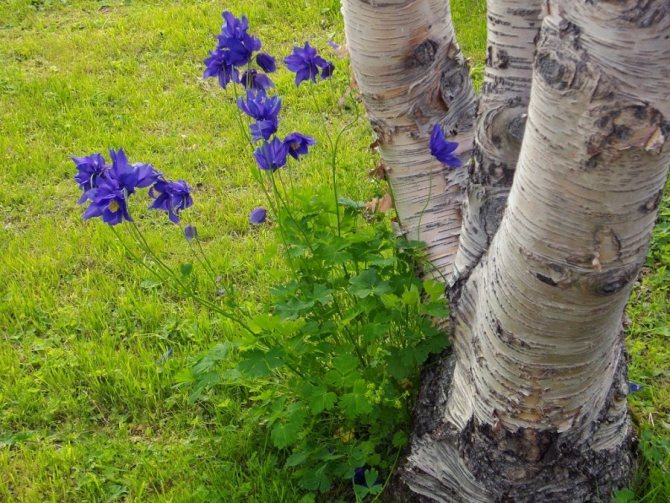

If the leaves of your plant look like someone was drawing a winding line, you have leaf miners. They are the larvae of various beetles, flies, moths and wasps.
An adult lays eggs on a leaf, and the larvae burrow and break through it, feed and leave a transparent trail where they were. If you look closely, you can often see a dark dot at the end of one of the stripes. This is a criminal at work.
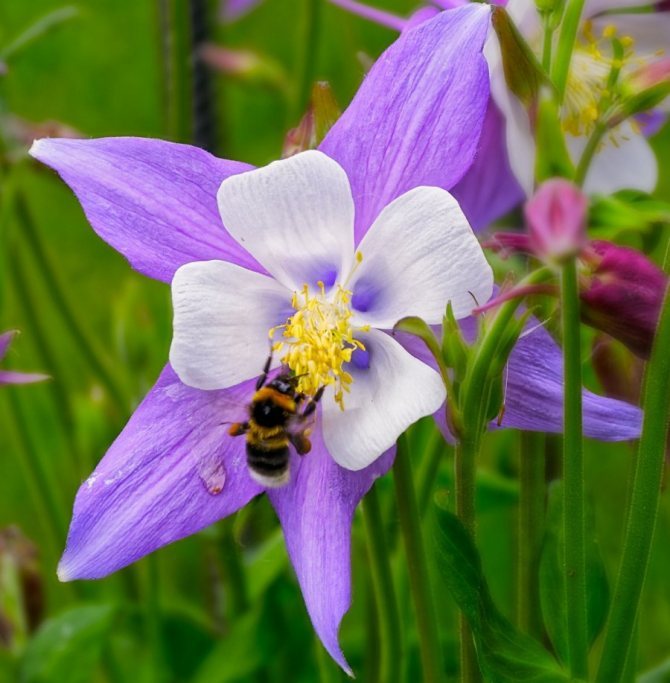

If you see a whitish translucent spot, it could also be a leaf miner. The damage from the spotted miner is often mistaken for some type of disease. The photo here is an okra leaf, but many plants are attacked by leaf miners.
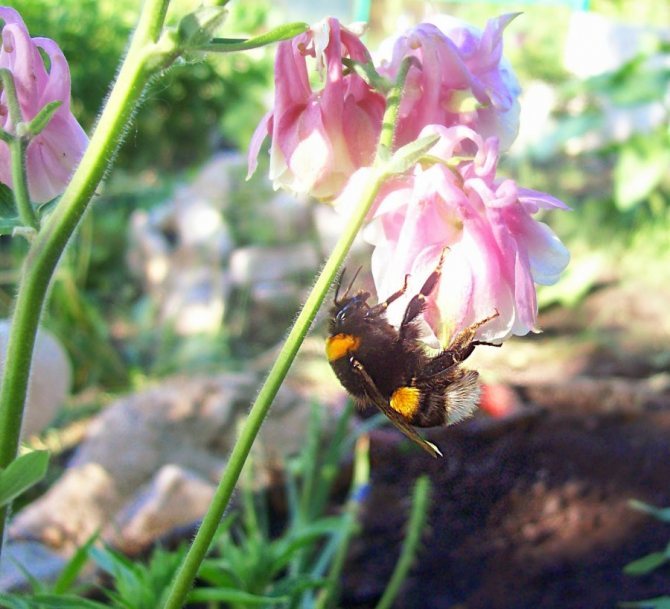

Growing aquilegia from seeds
The seeds of the plant are used for sowing immediately after they are harvested, that is, in the fall. However, if it was not possible to do this immediately, then it is better to store them until spring in a cold place, having previously mixed them with earth.
When spring comes, the seeds require washing, then they can be planted in boxes, in the so-called soil, consisting of equal proportions of sand, humus and leafy earth. A thin layer of soil is poured over the sown seeds and covered with newspaper or burlap. The aquilegia flower is a lover of shaded areas and relative warmth, no higher than +18, it needs constant light watering. The first shoots can be expected after two weeks. As soon as the first leaves appear on the horizon, this is a sign for planting seedlings over a wider area.
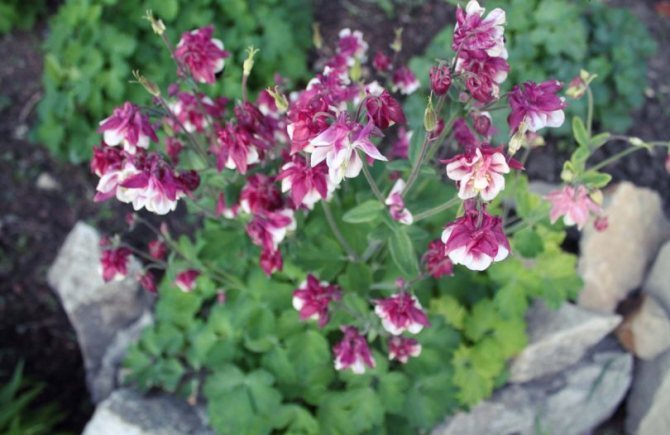

Aquilegia is a lover of shady places

